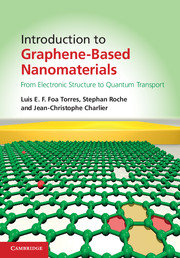Book contents
- Frontmatter
- Contents
- Preface
- 1 Introduction to carbon-based nanostructures
- 2 Electronic properties of carbon-based nanostructures
- 3 Quantum transport: general concepts
- 4 Klein tunneling and ballistic transport in graphene and related materials
- 5 Quantum transport in disordered graphene-based materials
- 6 Quantum transport beyond DC
- 7 Ab initio and multiscale quantum transport in graphene-based materials
- 8 Applications
- Appendix A Electronic structure calculations: the density functional theory (DFT)
- Appendix B Electronic structure calculations: the many-body perturbation theory (MBPT)
- Appendix C Green's functions and ab initio quantum transport in the Landauer–Büttiker formalism
- Appendix D Recursion methods for computing the DOS and wavepacket dynamics
- References
- Index
Appendix D - Recursion methods for computing the DOS and wavepacket dynamics
Published online by Cambridge University Press: 05 February 2014
- Frontmatter
- Contents
- Preface
- 1 Introduction to carbon-based nanostructures
- 2 Electronic properties of carbon-based nanostructures
- 3 Quantum transport: general concepts
- 4 Klein tunneling and ballistic transport in graphene and related materials
- 5 Quantum transport in disordered graphene-based materials
- 6 Quantum transport beyond DC
- 7 Ab initio and multiscale quantum transport in graphene-based materials
- 8 Applications
- Appendix A Electronic structure calculations: the density functional theory (DFT)
- Appendix B Electronic structure calculations: the many-body perturbation theory (MBPT)
- Appendix C Green's functions and ab initio quantum transport in the Landauer–Büttiker formalism
- Appendix D Recursion methods for computing the DOS and wavepacket dynamics
- References
- Index
Summary
The Lanczos tridiagonalization method orthogonally transforms a real symmetric matrix A to symmetric tridiagonal form. Traditionally, this very simple algorithm is suitable when one needs only a few of the lower eigenvalues and the corresponding eigenvectors of very large Hermitian matrices, whose full diagonalization is technically impossible. We introduce here the basic ingredients of the recursion method based on the Lanczos tridiagonalization, and explain how calculation of the DOS as well as the dynamics of wavepackets (and related conductivity) can be performed efficiently.
Lanczos method for the density of states
The Lanczos method is a highly efficient recursive approach for calculation of the electronic structure (Lanczos, 1950). This method, first developed by Haydock, Heine, and Kelly (Haydock, Heine & Kelly, 1972, 1975), is based on an eigenvalue approach due to Lanczos. It relies on computation of Green functions matrix elements by continued fraction expansion, which can be implemented either in real or reciprocal space. These techniques are particularly well suited for treating disorder and defect-related problems, and were successfully implemented to tackle impurity-level calculations in semiconductors using a tight-binding approximation (Lohrmann, 1989), and for electronic structure investigations for amorphous semiconductors, transition metals, and metallic glasses based on linear-muffin-tin orbitals (Bose, Winer & Andersen, 1988). Recent developments include the exploration of a degenerated orbital extended Hubbard Hamiltonian of system size up to ten millions atoms, with the Krylov subspace method (Takayama, Hoshi & Fujiwara, 2004, Hoshi et al., 2012).
- Type
- Chapter
- Information
- Introduction to Graphene-Based NanomaterialsFrom Electronic Structure to Quantum Transport, pp. 358 - 369Publisher: Cambridge University PressPrint publication year: 2014



